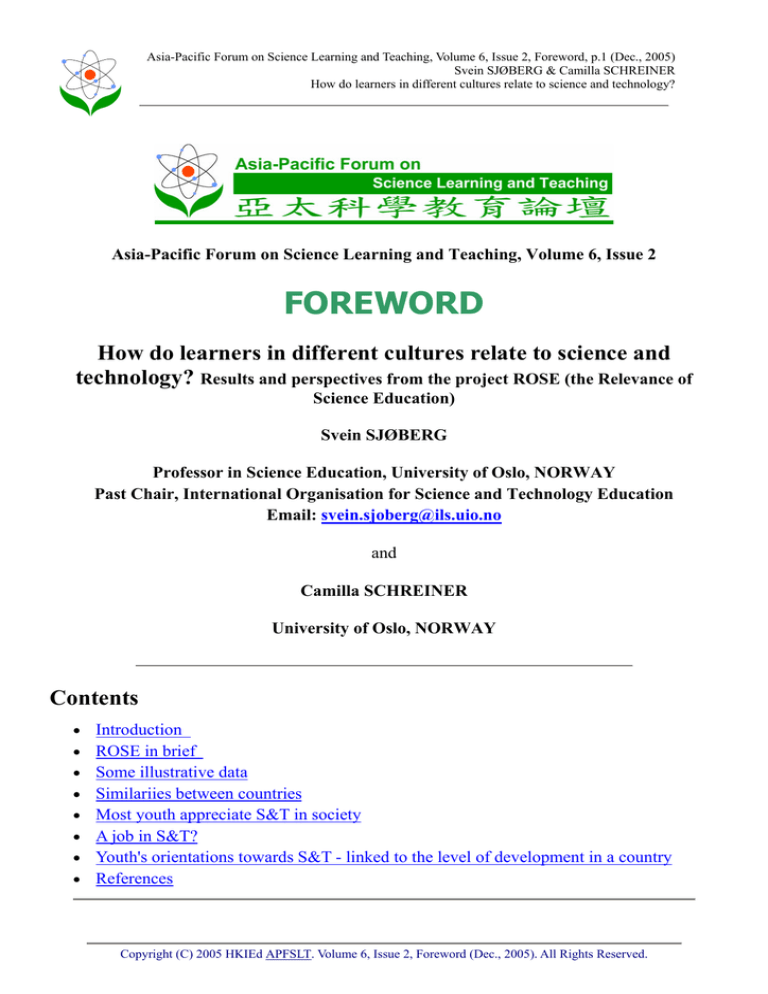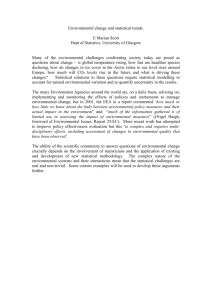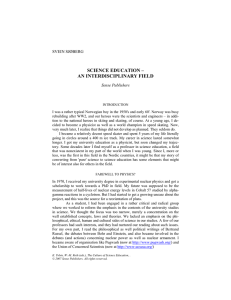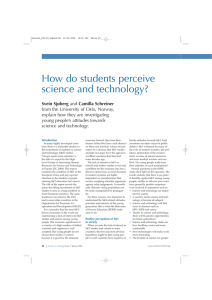Document 11387181
advertisement

Asia-Pacific Forum on Science Learning and Teaching, Volume 6, Issue 2, Foreword, p.1 (Dec., 2005) Svein SJØBERG & Camilla SCHREINER How do learners in different cultures relate to science and technology? Asia-Pacific Forum on Science Learning and Teaching, Volume 6, Issue 2 FOREWORD How do learners in different cultures relate to science and technology? Results and perspectives from the project ROSE (the Relevance of Science Education) Svein SJØBERG Professor in Science Education, University of Oslo, NORWAY Past Chair, International Organisation for Science and Technology Education Email: svein.sjoberg@ils.uio.no and Camilla SCHREINER University of Oslo, NORWAY Contents • • • • • • • • Introduction ROSE in brief Some illustrative data Similariies between countries Most youth appreciate S&T in society A job in S&T? Youth's orientations towards S&T - linked to the level of development in a country References Copyright (C) 2005 HKIEd APFSLT. Volume 6, Issue 2, Foreword (Dec., 2005). All Rights Reserved. Asia-Pacific Forum on Science Learning and Teaching, Volume 6, Issue 2, Foreword, p.2 (Dec., 2005) Svein SJØBERG & Camilla SCHREINER How do learners in different cultures relate to science and technology? Introduction1 The position of science and technology (S&T) in a society changes through time and from one society to another. In developing countries, many young people would like to opt for a career in S&T, while many rich highly developed countries notice declining recruitment of students to science and technology studies. "Europe needs more scientists!" is the title of the final report from a large EU project addressing the condition of science and technology in EU, with special attention to the number of people entering S&T educations and careers (EU, 2004). The title of the report reveals the point: The falling recruitment to most S&T educations is seen as a large problem in most European countries. The same tendencies are noted in the US (NSB, 2004) and in most other OECD-countries. There are large and interesting differences between the countries, both in respect of number of students, which subjects with the weakest recruitment, how large the recruitment problem is perceived to be, etc. Especially the "hard" S&T-subjects, such as technology, engineering, physics and to some extent chemistry are stricken. In addition, the gender differences vary from one country to another. In most countries, although with large variations, the boys outnumber the girls in physics and engineering studies, while the gender balance is shifted towards the girls in studies like medicine, veterinary medicine, environmental science and biology. The lack of relevance of the S&T curriculum is seen as one of the greatest barriers for good learning and as the reason for young peoples' low interest in the school subject and lack of motivation for pursuing the subject in their higher education. ROSE, The Relevance of Science Education, is an international comparative project meant to shed light on affective factors of importance to the learning of science and technology. The target population is students towards the end of secondary school (age 15). The research instrument is a questionnaire mostly consisting of closed questions with four-point Likert scales. The rationale behind the project, including the questionnaire development, theoretical background, procedures for data collection, etc. is described in Schreiner and Sjøberg (2004) available in print from the authors or from the project website2. In this 1 This article draws on material from the following publications: Schreiner, 2006; Schreiner & Sjøberg, 2004, 2005; Schreiner & Sjøberg, 2006 2 www.ils.uio.no/forskning/rose/ Copyright (C) 2005 HKIEd APFSLT. Volume 6, Issue 2, Foreword (Dec., 2005). All Rights Reserved. Asia-Pacific Forum on Science Learning and Teaching, Volume 6, Issue 2, Foreword, p.3 (Dec., 2005) Svein SJØBERG & Camilla SCHREINER How do learners in different cultures relate to science and technology? article, we will present the ROSE project, and include a few general results from analysis of the data material. In the discussion of the results, special attention will be paid to the countries at the Asian continent. ROSE in brief The key feature of ROSE is to gather and analyse information from the learners about several factors that have a bearing on their attitudes to S&T and their motivation to learn S&T. Examples are: A variety of S&T-related out-of-school experiences, their interests in learning different S&T topics in different contexts, their prior experiences with and views on school science, their views and attitudes to science and scientists in society, their future hopes, priorities and aspirations, their feeling of empowerment with regards to environmental challenges, etc. ROSE has, through international deliberations, workshops and piloting among many research partners, developed an instrument that aims to map out attitudinal or affective perspectives on S&T in education and in society as seen by 15 year old learners. The ROSE advisory group comprises key international science educators from all continents, among them several from Asia3. We have tried to make an instrument that can be used in widely different cultures. The aim is to stimulate research cooperation and networking across cultural barriers and to promote an informed discussion on how to make science education more relevant and meaningful for learners in ways that respect gender differences and cultural diversity. We also hope to shed light on how we can stimulate the students' interest in choosing S&T-related studies and careers – and to stimulate their life-long interest in and respect for S&T as part of our common culture. About 40 countries are taking part in ROSE. Although most countries have finished the data collection, some countries have still not completed the survey, and others are in an initial stage of organising it. ROSE partners have met at conferences like ESERA and 3 The group had, in addition to the Norwegian team, the following members: Dir. Vivien M. Talisayon (The Philippines), Dr. Jane Mulemwa (Uganda), Dr. Debbie Corrigan (Australia), Dir. Jayshree Mehta (India), Professor Edgar Jenkins (England), Dir. Vasilis Koulaidis (Greece), Dr. Ved Goel (The Commonwealth, now India), professor Glen Aikenhead (Canada) and professor Masakata Ogawa (Japan). Copyright (C) 2005 HKIEd APFSLT. Volume 6, Issue 2, Foreword (Dec., 2005). All Rights Reserved. Asia-Pacific Forum on Science Learning and Teaching, Volume 6, Issue 2, Foreword, p.4 (Dec., 2005) Svein SJØBERG & Camilla SCHREINER How do learners in different cultures relate to science and technology? IOSTE, and special ROSE workshops have been hosted in Europe. From the Asian continent, the following countries have finalised their data collection: Bangladesh, India, Israel, Japan, Malaysia, Philippines and Turkey. From other continents, the survey has been carried out in Botswana, the Czech Republic, Denmark, England, Estonia, Finland, Ghana, Greece, Iceland, Ireland, Latvia, Lesotho, Malawi, Norway, Northern Ireland, Poland, Portugal, Slovakia, South Africa, Russia, Spain, Sweden, Swaziland, Trinidad and Tobago, Uganda, Zimbabwe4. In some countries the ROSE target population is defined as the students in one region of the country (e.g. Karelia in Russia, Gujarat in India and the Central region in Ghana). Although the data collection for the initial reporting is finalised, new research partners may still use the ROSE instrument for their own research purposes after agreeing with the project organisers. The ROSE instrument is translated into many different languages. The questionnaire is copyrighted, but the project organisers may make them available for other partners. ROSE is supported by The Research Council of Norway, The Ministry of Education in Norway, The University of Oslo and the newly established National Centre for Science Education. Industrialised countries cover their own expenses, while some funding for data collection has been provided for developing countries and countries with less available resources. Participation in the project has in many countries, led to the release of local funding for the participants. The ROSE material may illuminate a range of important and topical discussions in the science education community, for example issues such as curricular content vs. students' interests, cultural diversity, students' disenchantment with their science classes and students' perceptions of science in society, gender differences. Discussions on such issues have been taking place in many papers and conference presentations based on the ROSE material (see e.g. Anderson, Sjøberg & Mikalsen, 2006; Jenkins, 2005; Jidesjö & Oscarsson, 2004; Lavonen, Juuti, Uitto, Meisalo & Byman, 2005; Ogawa & Shimode, 4 In order to not make the diagrams too extensive, data from only 25 countries are used in this article. The criteria for selecting some countries and excluding others are related to issues of sample and data quality. Copyright (C) 2005 HKIEd APFSLT. Volume 6, Issue 2, Foreword (Dec., 2005). All Rights Reserved. Asia-Pacific Forum on Science Learning and Teaching, Volume 6, Issue 2, Foreword, p.5 (Dec., 2005) Svein SJØBERG & Camilla SCHREINER How do learners in different cultures relate to science and technology? 2004; Trumper, 2004). About 10 PhD students are basing their thesis on ROSE data, and the first PhD-thesis was submitted in Norway in November 2005 (Schreiner, 2006). Some illustrative data It is in the nature of quantitative research to compare groups of students rather than individuals. In such studies, students are categorised according to, for example, sex, age, socioeconomic status of the home, religion, race, language, school type and urban/rural place of living. All research based on groups of respondents entails a loss of information at the level of the individual. This means that quantitative data facilitates characteristics of the typical – but inevitably at the expense of the particular. In the present study, too, groups of respondents will be the unit of the research. The individuals are categorised into gender categories. Characteristics of girls and boys, represented by mean scores for all students of the same gender, will unavoidably do injustice to the individuals. The focus of this study is on the typical, rather than on the particular. Thus, this injustice is a compromise that the study will make. We will report some results from analysis of the ROSE material. Here, our focus will be on students in Asian countries, but in order to understand these young people better, they will be studied against a background of youth from other continents and cultures. Therefore, we will also report on data collected in other countries. All diagrams show mean scores for 14-16 years old girls and boys from a number of countries in the ROSE sample. The countries are sorted partly geographically, with neighbouring countries together; and partly by level of development, with more modernised countries in the bottom. The participating researchers in different countries were requested to apply random sampling methods. For various reasons, e.g. due to limited financial resources, some countries have not been able to comply with the request. This means that not all of the 40 participating countries have samples that without reservation can be regarded as representative for 15 years old students in the country5. In some diagrams in this article, results from a single country may differ from the general pattern in the diagram. Here, we will not discuss whether such peculiarities might have been caused by errors in the 5 National reports on how the survey was organised in each country are available from the ROSE website http://www.ils.uio.no/forskning/rose/ Copyright (C) 2005 HKIEd APFSLT. Volume 6, Issue 2, Foreword (Dec., 2005). All Rights Reserved. Asia-Pacific Forum on Science Learning and Teaching, Volume 6, Issue 2, Foreword, p.6 (Dec., 2005) Svein SJØBERG & Camilla SCHREINER How do learners in different cultures relate to science and technology? measurement, the coding, the translation, etc., or by particular cultural-, political- or school-related issues. The Likert scales have four response categories, and the response categories vary from one question to another. Questions A, C and E have the heading: What I want to learn about. The questions are inventories of possible topics to learn about, each with a 4-point Likert scale. The extreme categories in the Likert scale are labelled Not interested (coded 1) and Very interested (coded 4). It is a rather lengthy question with a total of 108 items. In order to avoid fatigue from the students, the items were grouped into three questions: question A, C and E; from now referred to as question ACE. Other questions have a list of statements, and the students were asked to indicate in a 4-point Likert scale whether they Disagree (coded 1) or Agree (coded 4). This means that the value 2.5 lies in the middle of the scale. We will in the following interpret average scores of 2.5 as the students in the country in average are neutral to the statement; that they neither agree nor disagree. Similarities between countries In question ACE we request the students to indicate how interested they are in learning about a variety of topics. One underlying hypothesis for this question is that in spite of few students choosing an S&T education and career, and in spite of research finding that many students do not like school science, many young people find aspects of S&T interesting. The ACE question provides empirical data on what topics various groups of students are interested in learning about. This insight can inform our discussions on how S&T curricula can be constructed in order to meet the interests of different groups of learners. Asking the students how interested they are in various topics is one approach for getting in touch with science lessons' potential for engagement. We do of course not argue that science curricula should be determined from student opinion polls on what they find interesting. But, on the other hand, we believe that the teaching of school science has the potential to enliven, motivate, enrich, engage and inspire the students. To achieve this, we need to be aware of the interests, hopes and priorities of the learners. Copyright (C) 2005 HKIEd APFSLT. Volume 6, Issue 2, Foreword (Dec., 2005). All Rights Reserved. Asia-Pacific Forum on Science Learning and Teaching, Volume 6, Issue 2, Foreword, p.7 (Dec., 2005) Svein SJØBERG & Camilla SCHREINER How do learners in different cultures relate to science and technology? For exploring similarities between countries in the ACE items, hierarchal cluster analysis is a useful explorative statistical tool. Results from the hierarchical cluster analysis can be presented in dendrograms. The dendrogram in Figure 1 below shows how similar or close the countries and country clusters are to each other: The branches illustrate how clusters are formed at different stages in the analysis and the distances between the clusters. Figure 1. Hierarchical cluster analysis of residual ACE mean scores for all countries. Proximity measure: squared Euclidean distance. Clustering method: between-groups linkage. To the left, we have inserted a column showing the national HDI values (UNDP, 2003). (Source: Schreiner, 2006) The distance along the horizontal axis from the point at which the clusters come into existence to the point at which they aggregate into a larger cluster represents the Copyright (C) 2005 HKIEd APFSLT. Volume 6, Issue 2, Foreword (Dec., 2005). All Rights Reserved. Asia-Pacific Forum on Science Learning and Teaching, Volume 6, Issue 2, Foreword, p.8 (Dec., 2005) Svein SJØBERG & Camilla SCHREINER How do learners in different cultures relate to science and technology? distinctness of the clusters. The distinctness tells us how different one cluster is from its closest neighbour. The more compact a cluster is, i.e. the further to the left the branches merge, the more similar to each other the countries are. Annually, the United Nations Development Programme (UNDP) publishes a Human Development Report (HDR) (UNDP, 2003). In each HDR, the countries are ranked according to a Human Development Index (HDI). The index is monitoring average national achievement in three dimensions of human development: income, education and health6. In this article, HDI will be used as an indicator for the level of development in a country. To the left in Figure 1, we have inserted a column showing the national HDI values. By reading the dendrogram from the right towards the left, we see that the meta-cluster contains three main clusters: (A) High HDI countries including all the European countries plus Japan and Trinidad and Tobago, (B) Medium HDI Oriental countries and (C) Low HDI African countries. As the length of the branch for all these three clusters are relatively long, they can be perceived as three distinctive clusters of countries. Cluster B is more similar to cluster A than cluster C is. One noticeable result from the analysis above is that similarities between countries in this part of the questionnaire seem to be determined by two properties: geographical closeness and level of development. The general pattern is that first, the countries merge with geographically neighbouring countries, and next, the group of neighbouring countries merge with groups of countries having a comparable level of development7. But the unifying effect of geographical closeness only works within a certain limit of diversity in development. For example, Japan is geographically closer to the Philippines and Malaysia than to Europe, but the Japanese students seem to have more interests in common with European students. This may possibly be explained by the relatively high 6 Definition: HDI is a summary measure of human development based on the weighted average of three indices: (1) a long and healthy life, as measured by life expectancy at birth, (2) education, as measured by the adult literacy rate (two-thirds weight) and the combined primary, secondary and tertiary education gross enrolment ratio (one-third weight), and (3) a decent standard of living, as measured by GDP per capita (PPP US$). (For details on how the index is calculated, see e.g. Technical note 1 in UNDP, 2004) 7 In spite of non-random sampling procedures, countries that are commonly considered as similar to each other (for example African, Baltic or Asian countries) do in most instances show similar or related response patterns. This can be seen as some validation of the data. Copyright (C) 2005 HKIEd APFSLT. Volume 6, Issue 2, Foreword (Dec., 2005). All Rights Reserved. Asia-Pacific Forum on Science Learning and Teaching, Volume 6, Issue 2, Foreword, p.9 (Dec., 2005) Svein SJØBERG & Camilla SCHREINER How do learners in different cultures relate to science and technology? level of development and industrialisation in Japan. The response profiles of students in the Oriental countries (like Malaysia, Philippines, India and Bangladesh) appear as relatively similar to each other. We should note that the Russian students' orientation towards science and science education appear as comparable to the profiles of the students in the Baltic countries (Latvia and Estonia). Keep in mind that the Russian students in ROSE come from Karelia, a region quite close to the Baltic countries and Finland. Most youth appreciate S&T in society A possible explanation for young people's lack of interest for studying S&T could be that they hold a negative view of the role that S&T play in society, and that they blame S&T for the unintended catastrophes and risks (e.g. the Chernobyl disaster in 1986, BSE (Bovine Spongiform Encephalopathy or "mad cow disease"), the depletion of the ozone layer, global warming and overpopulation) following in the wake of the technological development (Beck, 1999; Sjøberg, 2004). Contrary to such expectations, the ROSE results indicate that youth express a positive view on S&T. Average scores for girls and boys in nearly all countries show strong agreement with statements like these: • • • • • • Science and technology will find cures to diseases such as HIV/AIDS, cancer, etc, Science and technology are important for society, Thanks to science and technology, there will be greater opportunities for future generations, New technologies will make work more interesting, The benefits of science are greater than the harmful effects it could have, and Science and technology make our lives healthier, easier and more comfortable. Figure 2 illustrates this with one example. The diagram shows responses to Science and technology are important for society. In average, girls and boys in all countries agree that S&T are important for society, and the gender differences are negligible. Copyright (C) 2005 HKIEd APFSLT. Volume 6, Issue 2, Foreword (Dec., 2005). All Rights Reserved. Asia-Pacific Forum on Science Learning and Teaching, Volume 6, Issue 2, Foreword, p.10 (Dec., 2005) Svein SJØBERG & Camilla SCHREINER How do learners in different cultures relate to science and technology? Uganda Ghana (Centr) Swaziland Zimbabwe Botswana Philippines Bangladesh India (Gujarat) Malaysia Trinidad & T Greece Portugal Russia (Karel) Poland Latvia Estonia Ireland N.Ireland England Japan Finland Iceland Sweden Denmark Norway 1.0 1.5 2.0 2.5 3.0 3.5 4.0 Figure 2. Science and technology are important for society. Average scores for boys (filled symbols) and girls (open symbols). "Trinidad & T" denotes Trinidad and Tobago. In general, youth in Malaysia, Philippines, India and Bangladesh are very positive, while Japanese youth are more hesitant. This is just noticeable in Figure 2, while in many other questions in the questionnaire, for example in Figure 3, Japanese youth express far more scepticism towards the role of S&T in society than youth from other countries: In average, Japanese students disagree that The benefits of science are greater than the harmful effects it could have. Copyright (C) 2005 HKIEd APFSLT. Volume 6, Issue 2, Foreword (Dec., 2005). All Rights Reserved. Asia-Pacific Forum on Science Learning and Teaching, Volume 6, Issue 2, Foreword, p.11 (Dec., 2005) Svein SJØBERG & Camilla SCHREINER How do learners in different cultures relate to science and technology? Uganda Ghana (Centr) Swaziland Zimbabwe Botswana Philippines Bangladesh India (Gujarat) Malaysia Trinidad & T Greece Portugal Russia (Karel) Poland Latvia Estonia Ireland N.Ireland England Japan Finland Iceland Sweden Denmark Norway 1.0 1.5 2.0 2.5 3.0 3.5 4.0 Figure 3. The benefits of science are greater than the harmful effects it could have. Average scores for boys (filled symbols) and girls (open symbols). "Trinidad & T" denotes Trinidad and Tobago. The reluctant attitude of the Japanese youth has gained attention elsewhere, for example in the Japanese newspaper Ashanti in December 2004. A job in S&T? We see from Figure 4 that there are large cross-national differences when it comes to students' agreement with the statement I would like to become a scientist. The mean scores in the developed countries are extremely low, and the girls are even more negative than the boys. Japan has particularly large gender differences. Copyright (C) 2005 HKIEd APFSLT. Volume 6, Issue 2, Foreword (Dec., 2005). All Rights Reserved. Asia-Pacific Forum on Science Learning and Teaching, Volume 6, Issue 2, Foreword, p.12 (Dec., 2005) Svein SJØBERG & Camilla SCHREINER How do learners in different cultures relate to science and technology? Uganda Ghana (Centr) Swaziland Zimbabwe Botswana Philippines Bangladesh India (Gujarat) Malaysia Trinidad & T Greece Portugal Russia (Karel) Poland Latvia Estonia Ireland N.Ireland England Japan Finland Iceland Sweden Denmark Norway 1.0 1.5 2.0 2.5 3.0 3.5 4.0 Figure 4. I would like to become a scientist. See caption 1 for diagram explanations. Responses to the item I would like to get a job in technology are illustrated in Figure 5. Also in this diagram, we note pronounced differences between countries and between girls and boys in each country. While boys in more developed countries give average scores close to the neutral value, most girls in these countries do not want to work with technology. In developing countries, both girls and boys agree with the statement. Also in these countries, there are some gender differences, but they are by no means as large as in the developed countries. Copyright (C) 2005 HKIEd APFSLT. Volume 6, Issue 2, Foreword (Dec., 2005). All Rights Reserved. Asia-Pacific Forum on Science Learning and Teaching, Volume 6, Issue 2, Foreword, p.13 (Dec., 2005) Svein SJØBERG & Camilla SCHREINER How do learners in different cultures relate to science and technology? Uganda Ghana (Centr) Swaziland Zimbabwe Botswana Philippines Bangladesh India (Gujarat) Malaysia Trinidad & T Greece Portugal Russia (Karel) Poland Latvia Estonia Ireland N.Ireland England Japan Finland Iceland Sweden Denmark Norway 1.0 1.5 2.0 2.5 3.0 3.5 4.0 Figure 5. I would like to get a job in technology. See caption 1 for diagram explanations. Youth's orientations towards S&T - linked to the level of development in a country Young people's values, views and ways of understanding themselves, their surroundings and the world are products of the culture in which they are growing up. Our data show a strong relationship between the HDI for a country and the responses in the ROSE questionnaire. For example, the national average score across all items in the ACE question (What I want to learn about), the Pearson product moment correlation coefficient with HDI is .85 (p < .01), which indicates a very strong inverse relationship: The higher level of development in a country, the lower interest the students express in learning about S&T-related topics. Copyright (C) 2005 HKIEd APFSLT. Volume 6, Issue 2, Foreword (Dec., 2005). All Rights Reserved. Asia-Pacific Forum on Science Learning and Teaching, Volume 6, Issue 2, Foreword, p.14 (Dec., 2005) Svein SJØBERG & Camilla SCHREINER How do learners in different cultures relate to science and technology? 3,25 Bangladesh Uganda Philippines India (Gujarat) Zimbabwe Botswana 3,00 Trinidad & T Swaziland Ghana (Centr) Malaysia Greece Russia (Karel) 2,75 Latvia Poland Portugal Ireland N. Ireland England Norway Estonia 2,50 Japan Sweden Iceland Denmark Finland 2,25 0,400 0,500 0,600 0,700 0,800 0,900 1,000 Figure 6. Scatter-plot with regression line: HDI values (horizontal axis) and the national average score across all items in the ACE question (vertical axis) for all countries. Figure 6 shows that the ACE mean for some of the countries in the extreme low end of the HDI scale lies one unit (in a scale with a span of three units) above many countries in the extreme high end of the HDI scale. In most of the ACE items, students in countries like Uganda and Bangladesh express much more interest in learning about the topics than students in more developed countries like Norway, Iceland, Finland and Japan. Also in the Philippines, youth express a general high level of interest. The correlation coefficients for the four questions reported in Figure 2-Figure 5 are given in Table 1. The table indicates the general pattern appearing from most analysis of the ROSE material: The more developed a country is, the less positive young people are towards the role of S&T in society. I would like to become a scientist -0.94 I would like to get a job in technology -0.91 Science and technology are important for society -0.78 The benefits of science are greater than the harmful effects it -0.73 could have Copyright (C) 2005 HKIEd APFSLT. Volume 6, Issue 2, Foreword (Dec., 2005). All Rights Reserved. Asia-Pacific Forum on Science Learning and Teaching, Volume 6, Issue 2, Foreword, p.15 (Dec., 2005) Svein SJØBERG & Camilla SCHREINER How do learners in different cultures relate to science and technology? Table 1. Pearson product moment correlation coefficient with HDI (p < .01). We see from our data that whether young people wish to opt for a career in S&T is closely related to the country's level of development. An important challenge in poor countries is of course related to the betterment of material conditions, economic growth and to the improvement of health and the welfare system. Further material development of the society is naturally a main political and public issue, and in this respect S&T are seen as fundamental driving forces. One may assume that in such societies, a job in S&T is perceived as important for society and thereby as meaningful for the individual. When today's modern societies were in the era of early industrialisation, the focus was directed towards progress, growth and building the country. Consequently, exactly this to build the country - was perceived as important for the society and meaningful for the individual. It may be that we now have passed the era in which the work of physicists, technicians and engineers are seen as crucial for people's life and well-being in the more developed countries. Studies also indicate that in poorer countries, young people have a rather heroic image of scientists as persons, while this is not the case in highly developed Western societies (Sjøberg, 2002). In modern societies, neither scientists nor engineers are heroes or attractive role models for the young generation. Obviously, the level of development influences people's expectations to the expected benefits of developments in S&T (Sicinski, 1976). The recent Eurobarometer (EU, 2005) also show that the belief in the benefits of S&T is much stronger in the less developed EU countries than in the wealthier and more developed8. According to Inglehart (1990), late modern societies can be characterised as post-materialistic societies emphasising values like environment, democracy, care for others, self-actualisation, etc. The recruitment of Western students to medicine, biology and environment studies are not falling, and in these subjects the girls often outnumber the boys. This may indicate that youth in more developed countries believe that the most important challenges facing our society are related to health and environmental issues, and, consequently, that these fields can offer meaningful jobs. We have seen that in an Asian context, Japan is facing some challenges concerning youth's interests and attitudes related to science and 8 The recent Eurobarometer (EU, 2005) has collected data in 32 countries: the 15 "old" EU countries, the 10 new member states (previously Eastern Europe), the four "candidate countries" Turkey, Croatia, Bulgaria and Romania and the three EFTA countries Iceland, Norway and Switzerland. Copyright (C) 2005 HKIEd APFSLT. Volume 6, Issue 2, Foreword (Dec., 2005). All Rights Reserved. Asia-Pacific Forum on Science Learning and Teaching, Volume 6, Issue 2, Foreword, p.16 (Dec., 2005) Svein SJØBERG & Camilla SCHREINER How do learners in different cultures relate to science and technology? technology, while the situation is less problematic in the Philippines, Bangladesh, Malaysia and India. We are looking forward to more analysis and interpretations of these results from our Asian ROSE partners, who are able to understand the Asian societies and cultures better. References Anderson, Ishmael K.; Sjøberg, Svein & Mikalsen, Øyvind. (2006).What kinds of science and technology do pupils in Ghanaian junior secondary schools want to learn about? Some results and comparisons based on the international ROSE study. In C. Julie & Mikalsen, Ø. (Eds.), Some Developments in Research in Science and Matehematics Education in Sub-Saharan Africa. Cape Town: University of Western Cape (in press). Beck, Ulrich. (1999). World Risk Society. Cambridge: Polity Press. EU (2004). Europe needs more scientists! Brussels: European Commission, Directorate-General for Research, High Level Group on Human Resources for Science and Technology in Europe. Available from: http://europa.eu.int/comm/research/conferences/2004/sciprof/pdf/final_en.pdf (accessed 2005-10-24). EU (2005). Europeans, science and technology. Special Eurobarometer224, Brussels: European Commision. (Available from http://europa.eu.int/comm/public_opinion/index_en.htm) Inglehart, Ronald. (1990). Culture Shift in Advanced Industrial Society. Princeton, New Jersey: Princeton University Press. Jenkins, Edgar W. (2005). Important but not for me: students' attitudes towards secondary school science in England. Research in Science & Technological Education, 23(1), 41-57. Jidesjö, Anders & Oscarsson, Magnus. (2004, 25-30 July). Students´ attitudes to science and technology. First results from The ROSE-project in Sweden. Paper presented at the XI IOSTE (International Organization for Science and Technology Education) symposium: Science and Technology Education for a Diverse World, Lublin, Poland. Lavonen, Jari; Juuti, Kalle; Uitto, Anna; Meisalo, Veijo & Byman, Reijo. (2005). Attractiveness of Science Education in the Finnish Comprehensive School. In A. Manninen, Miettinen, K. & Kiviniemi, K. (Eds.), Research Findings on Young People’s Perceptions of Technology and Science Education. Mirror results and good practice. Helsinki: Technology Industries of Finland. NSB (2004). Science and Engineering Indicators 2004 (NSB 04-01). Arlington, VA: National Science Board, National Science Foundation. Available from: www.nsf.gov/nsb/documents/reports.htm (accessed 2005-10-24) Ogawa, Masakata & Shimode, Shoko. (2004). Three distinctive groups among Japanese students in terms of their school science preference: From preliminary analysis of Japanese data of an Copyright (C) 2005 HKIEd APFSLT. Volume 6, Issue 2, Foreword (Dec., 2005). All Rights Reserved. Asia-Pacific Forum on Science Learning and Teaching, Volume 6, Issue 2, Foreword, p.17 (Dec., 2005) Svein SJØBERG & Camilla SCHREINER How do learners in different cultures relate to science and technology? international survey "The Relevance of Science Education" (ROSE). Journal of Science Education in Japan, 28(4), 279-291. Schreiner, Camilla. (2006). Exploring a ROSE-garden. Norwegian youth's orientations towards science - seen as signs of late modern identities. Based on ROSE (The Relevance of Science Education), a comparative study of 15 year old students' perceptions of science and science education. Doctoral thesis, University of Oslo, Faculty of Education, Department of Teacher Education and School Development, Oslo (not yet official or published). Schreiner, Camilla & Sjøberg, Svein (2004). Sowing the seeds of ROSE. Background, Rationale, Questionnaire Development and Data Collection for ROSE (The Relevance of Science Education) - a comparative study of students' views of science and science education (Acta Didactica 4/2004). Oslo: Dept. of Teacher Education and School Development, University of Oslo. Available from: www.ils.uio.no/forskning/publikasjoner/actadidactica/index.html (accessed 2005-08-06). Schreiner, Camilla & Sjøberg, Svein. (2005). Et meningsfullt naturfag for dagens ungdom? [A meaningful school science for today's youth?]. Nordina(2), 18-35. Schreiner, Camilla & Sjøberg, Svein. (2006). Science education and youth's identity construction two incompatible projects? In D. Corrigan, Dillon, J. & Gunstone, R. (Eds.), The Re-emergence of Values in the Science Curriculum: Sense Publications (in progress). Sicinski, Andrzej. (1976). The future: A dimension being discovered. In H. Ornauer, Wiberg, H., Sicinski, A. & Galtung, J. (Eds.), Images of the world in the year 2000 (p. 121-159). Atlantic Highlands N.J.: Humanities Press. Sjøberg, Svein (2002). Science for the children? Report from the Science and Scientists-project -Acta Didactica. -(1/2002) Dept. of Teacher Education and School Development, University of Oslo. Sjøberg, Svein. (2004). Naturfag som allmenndannelse: en kritisk fagdidaktikk [Science as general education. A critical approach] (second ed.). Oslo: Gyldendal Akademisk. Trumper, Ricardo. (2004, 25-30 July). Israeli Students' Interests in Physics and its Relation to their Attitude towards Science and Technology and to their own Science Classes. Paper presented at the XI IOSTE (International Organization for Science and Technology Education) symposium: Science and Technology Education for a Diverse World, Lublin, Poland. UNDP (2003). Human Development Report 2003: Millennium Development Goals: A compact among nations to end human poverty. New York: United Nations Development Programme. Available from: http://hdr.undp.org/ (accessed 2005-09-10). UNDP (2004). Human Development Report 2004. Cultural liberty in today's diverse world. New York: United Nations Development Programme. Available from: http://hdr.undp.org/ (accessed 2005-09-10). Copyright (C) 2005 HKIEd APFSLT. Volume 6, Issue 2, Foreword (Dec., 2005). All Rights Reserved.



![teresa%20%20amezquita[1].](http://s2.studylib.net/store/data/010003923_1-8c6fcf8f7e07f777f47e6b8240aecb9b-300x300.png)


